Genus Rhinopithecus | Phylum Chordata Family Cercopithecidae Scientific name Rhinopithecus strykeri Rank Species | |
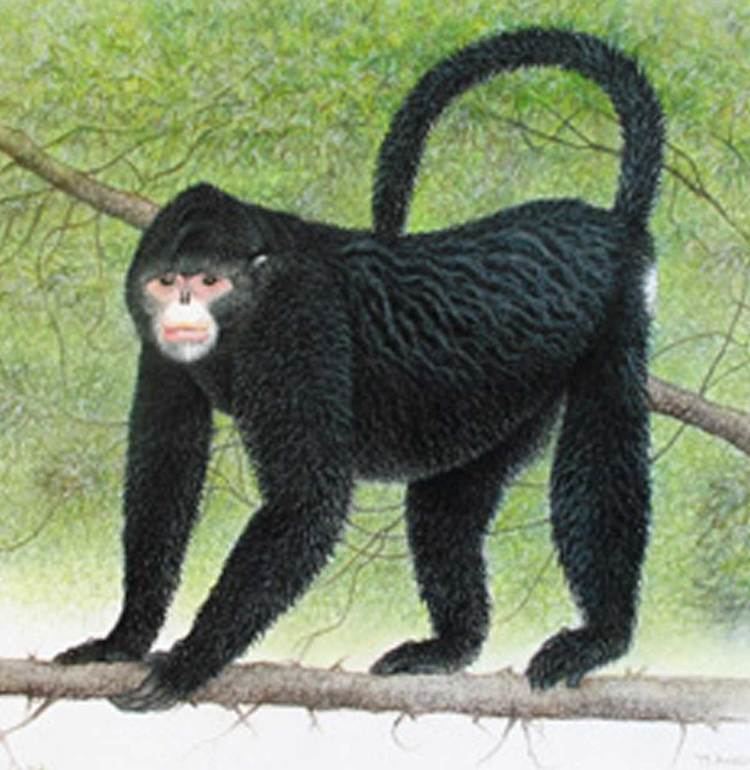 | ||
Similar Snub‑nosed monkey, Primate, Gray snub‑nosed monkey, Black snub‑nosed monkey, Mammal | ||
World s first footage of the newly discovered myanmar snub nosed monkey
The Myanmar snub-nosed monkey or Burmese snub-nosed monkey (Rhinopithecus strykeri) is a critically threatened species of colobine monkey discovered in 2010 in northern Burma (Myanmar). It was formally described as a novel species of primate in 2011 based on its fur, beard and tail. A group of the species was discovered in China in 2011.
Contents
- World s first footage of the newly discovered myanmar snub nosed monkey
- Scientific identification and taxonomy
- Physical characteristics
- Distribution and habitat
- Conservation status
- Origin and Evolution
- Recognition
- References
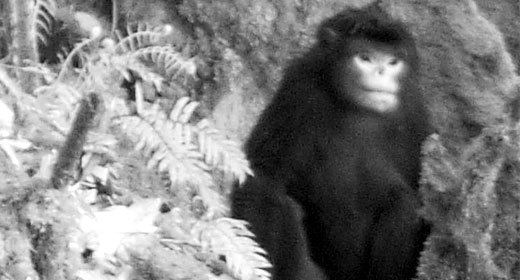
The species is known in local dialects of Lisu people as mey nwoah and Law Waw people as myuk na tok te, both of which mean "monkey with an upturned face". Rain allegedly causes it to sneeze due to the short upturned nasal flesh around its nostrils. People from the area report that it sits with its head directed downwards, hiding its face between its knees when it rains.
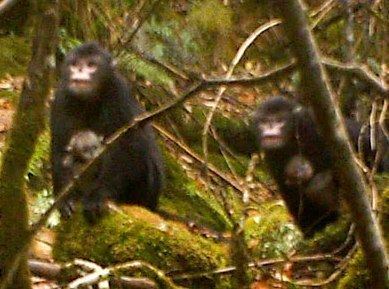
Scientific identification and taxonomy

The species came to the attention of a team of scientists allied to the "Myanmar Primate Conservation Program" researching the status of the hoolock gibbon in early 2010. The team, led by Swiss primatologist Thomas Geissman and Ngwe Lwin of the Myanmar Biodiversity and Nature Conservation Association (BANCA), were supported by Fauna & Flora International (FFI) and the People Resources and Conservation Foundation (PRCF). The specific name strykeri is given in honour of philanthropist Jon Stryker, president and founder of the Arcus Foundation, which also sponsored the project.
The type specimen was identified from the Maw River area of northeastern Kachin state in northeastern Burma. The specimen most closely examined was the skull (with mandible) and skin of a gutted adult male obtained from hunters in Pade, subsequently deposited in the Anthropological Institute and Museum of the University of Zürich. Additional sample skulls of animals killed some three years earlier, one male and one female, were also collected along with a bag made out of the skin of a juvenile caught in January 2010, all obtained in Htantan village.
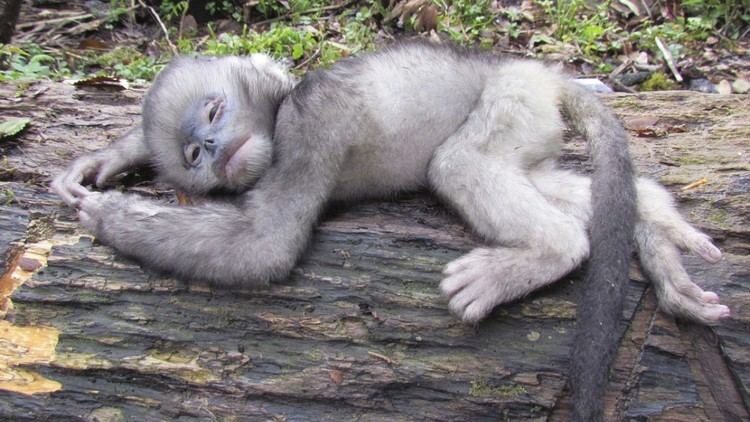
The team encountered seven live specimens, including an infant, but these moved out of sight before they could be photographed or studied in detail. A camera trap set by a team of FFI, BANCA and PRCF researchers captured the first known images of live snub-nosed monkeys in January 2012.
Physical characteristics
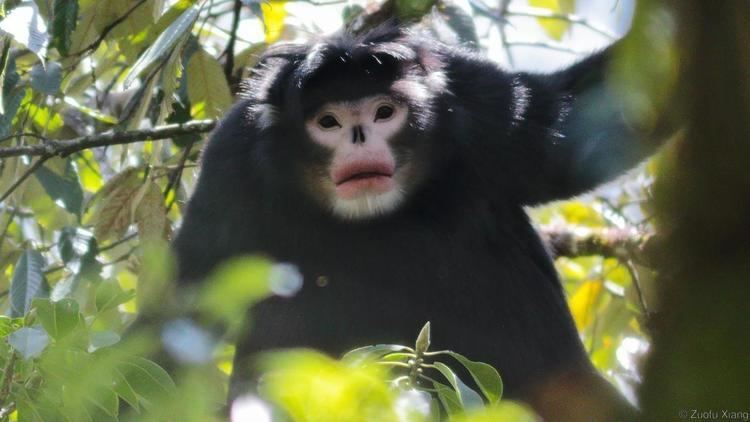
The monkey's fur is mostly black. Its crown consists of a thin, high, forward-curved crest of long, black hairs. It has protruding white ear tufts, a mostly naked face with pale pink skin, a “moustache” of whitish hairs above the upper lip, and a distinct white chin beard. The perineal area is white and clearly defined, and the limbs are mostly black; the inner sides of the upper arms and upper legs are blackish brown. The lips are prominent, and the nose upturned, allegedly causing the animal to sneeze in rainy weather. Its tail is approximately 1.4 times the body length: the first sample, an adult male, has a head-body length of 55.5 centimetres (21.9 in), and a tail 78 cm (31 in) long.
Distribution and habitat
The species spend summer months in temperate mixed forests at upper altitudes of their range, and descend to lower ground in the winter to escape snow.
When first discovered, the only known specimens existed in three or four groups within a 270 square kilometres (100 sq mi) range at 1,700 to 3,200 metres (5,600–10,500 ft) above sea level in the eastern Himalayas, in the north-eastern section of Kachin State, the northernmost part of Burma (Myanmar). In 2011, a population was discovered in Lushui County, Yunnan, China. The species is isolated from other snub-nosed Rhinopithecus by the Mekong and the Salween rivers; the other 4 species, golden, black, gray and Tonkin snub-nosed monkeys, are found in China and Vietnam. The species shares habitat with Shortridge's langur, stump-tailed macaque, Assam macaque, rhesus macaque, and northern pig-tailed macaque.
On the morning of 16 October 2011, a forest guard at Gaoligongshan National Nature Reserve (GNNR), China took photos of a group of snub-nosed monkeys which were later identified as R. strykery. This made a breaking headline in China especially on the urgent need for a conservation programme.
Conservation status
Deforestation due to logging operations, isolation and hunting by local humans for food are considered dangers to the small extant population. The known Burmese population size is 260-330 individuals, and it is believed less than 100 remain in China. It is recognized as critically endangered by the IUCN. The Chinese population is found within the Gaoligongshan National Nature Reserve and it has been proposed to create a national park to protect this species in Burma.
Origin and Evolution
Snub-nosed monkeys and the langurs are the two major groups of colobine monkeys in Asia. The monophyletic origin of these Asian monkeys are already established through molecular phylogeny using nuclear and mitochondrial DNAs. To further resolve the evolutionary status of these monkeys with emphasis on R. strykery, primatologists at German Primate Center analysed the complete mitochondrial genomes and 12 nuclear loci, including one X chromosomal, six Y chromosomal and five autosomal loci, from all ten odd-nosed monkey species. Their findings in 2012 revealed that snub nosed Rhinopithecus group represent the most basal lineage, with Nasalis and Simias forming the closest group, which implies that these odd-nosed monkeys originated from northern Burma and a later expanded into Indochina and Sundaland. The snub-nosed group diverged from other Asian monkeys about 6.8-6 million years ago, and from Nasalis and Simia clade about 1.2 Ma. Further, various species of the snub-nosed group split from each other about 730,000-400,000 years ago.
Recognition
Taxonomic experts at the International Institute for Species Exploration honoured the monkey species as one of the Top 10 New Species 2012 among new species described in 2011 throughout the world. Its unique appearance, behaviour and vulnerability make it outstanding and not only in novelty, but also in conservation issues. It has even earned a new nickname "the sneezing monkey" for its peculiar behaviour. In 2012 it was also listed at no 9 of the Top 10 weirdest new species by the Chinese news portal, China.org.cn.
